As I walked up a steep hill I took the time to feel the warm sand beneath my toes as I took each step. When I reached the summit, I pivoted and marvelled at the scenery before my very eyes. Panoramic views of jagged rock formations on a bed of sand left a lasting impression. Each rock formation was so distinct it appeared it had been individually hand carved by an artist. I snapped a few photos and then I put my camera down and sat down in awe – some places are just worth the extra attention.
Visiting Wadi Rum was one of the true highlights of our journey to Jordan. Known also as The Valley of the Moon, its name derived from the Aramaic root of ‘elevated’ and has been inhabited by many human civilizations over the years – most notably the Nabateans. Home to the Zalabria Bedouin, the region is one of the most popular eco-adventure tourism spots in all of Jordan. From treks to camel safaris to cultural experiences there is something for everyone to enjoy.
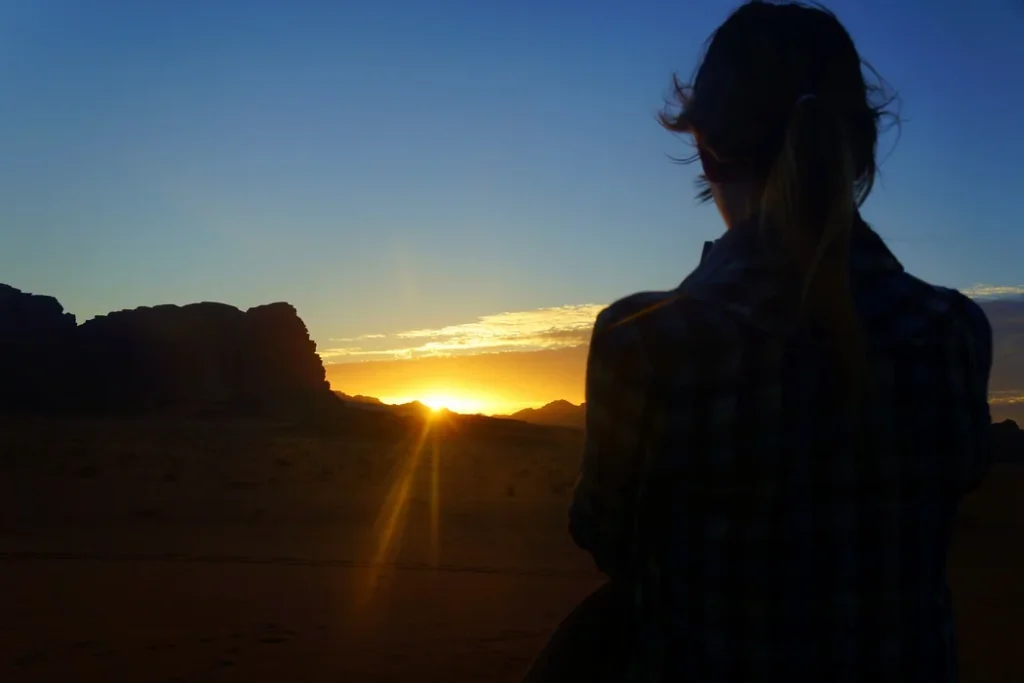
Introduction to Wadi Rum
Among Jordan’s many treasures, Wadi Rum emerges as a crown jewel—a vast, echoing landscape that feels almost otherworldly. Also known as the “Valley of the Moon,” Wadi Rum is a protected desert wilderness in southern Jordan. It’s characterized by towering sandstone mountains, sweeping sand dunes, and ancient rock carvings dating back thousands of years.
The desert’s striking beauty hasn’t gone unnoticed by storytellers and filmmakers. Wadi Rum’s dramatic landscapes have served as the backdrop for numerous films, most notably “Lawrence of Arabia,” which immortalized the desert’s allure on the silver screen. This film chronicles the life of T.E. Lawrence, a British officer instrumental during the Arab Revolt, and his experiences in this very desert.
More recently, Wadi Rum has doubled as the surface of Mars in films like “The Martian” and “Rogue One: A Star Wars Story,” highlighting its alien and timeless qualities. These features captivate both directors and audiences alike.
Visitors to Wadi Rum are often struck by the serenity and grandeur of the environment. The shifting colors of the sands and rocks—ranging from deep reds to soft oranges—create a canvas that changes with the movement of the sun. Majestic natural arches, towering cliffs, and narrow canyons invite exploration and adventure.
At night, the sky becomes a tapestry of stars, unblemished by city lights. It offers a celestial spectacle that few places on Earth can match. Stargazing in Wadi Rum is an unforgettable experience, allowing visitors to reconnect with the natural world in a profound way.
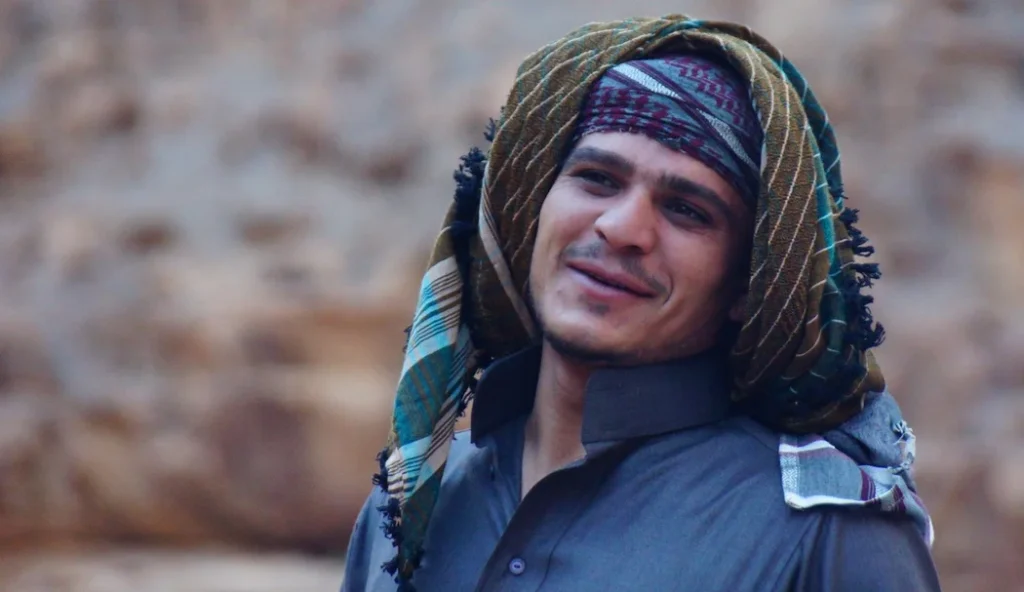
The Bedouin Culture
At the heart of Wadi Rum’s enchantment is the enduring presence of the Bedouin people, the desert’s indigenous inhabitants who have called this harsh landscape home for centuries. The Bedouins are a nomadic Arab tribe whose history in the region is steeped in tradition and survival.
Their profound connection to the land is evident in their deep understanding of the desert’s rhythms, weather patterns, and the secrets that allow life to flourish in such an unforgiving environment.
The Bedouins are renowned for their hospitality, a cornerstone of their culture and traditions. In a land where resources are scarce, the practice of welcoming strangers and offering shelter, food, and protection is not just a social nicety. It’s a way of life ingrained in their very identity.
Guests are treated with the utmost respect. Sharing stories over a cup of traditional sweet mint tea or cardamom-spiced coffee is a cherished ritual. This hospitality extends to sharing meals, often featuring traditional dishes cooked over open fires, providing an authentic taste of Bedouin life.
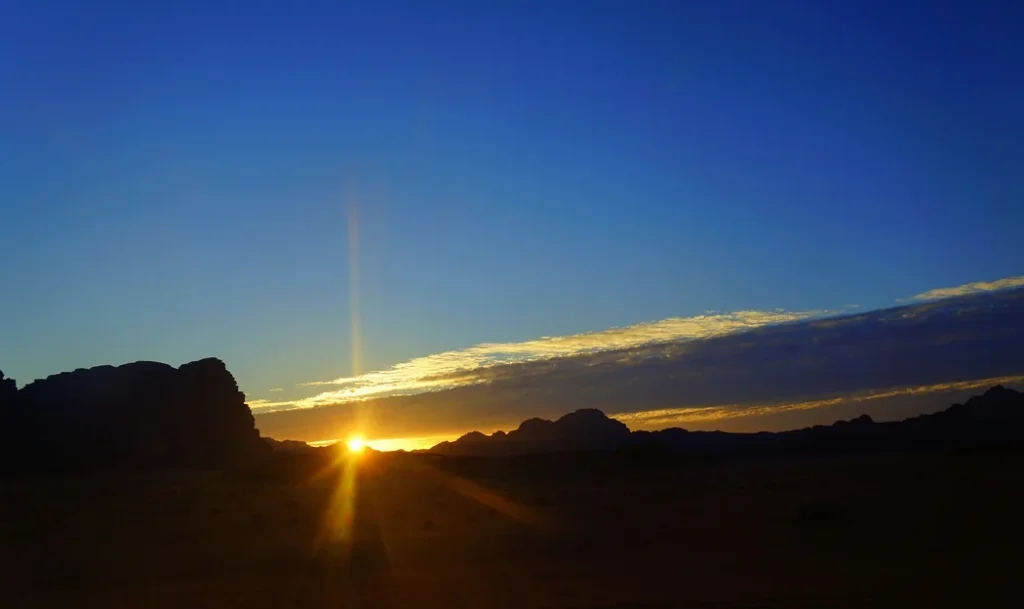
Their history is rich with tales of:
- Nomadic life
- Camel caravans that once traversed vast distances for trade
- A profound appreciation for the simplicity and beauty of desert living
Bedouin traditions are passed down through generations, often through storytelling, poetry, and music, which play significant roles in preserving their cultural heritage. The haunting melodies of the rebab, a traditional string instrument, and the rhythmic beats of drums echo under the starlit skies. They invite visitors to partake in a cultural journey like no other.
Staying in a Bedouin camp provides a unique opportunity to immerse oneself in this ancient culture. It allows travelers to gain insights into their way of life, customs, and the timeless rhythms of desert living.
From learning about traditional handicrafts and camel herding to understanding their sustainable practices and deep respect for nature, engaging with the Bedouin people enriches the journey through Wadi Rum. It leaves lasting memories and newfound appreciations.
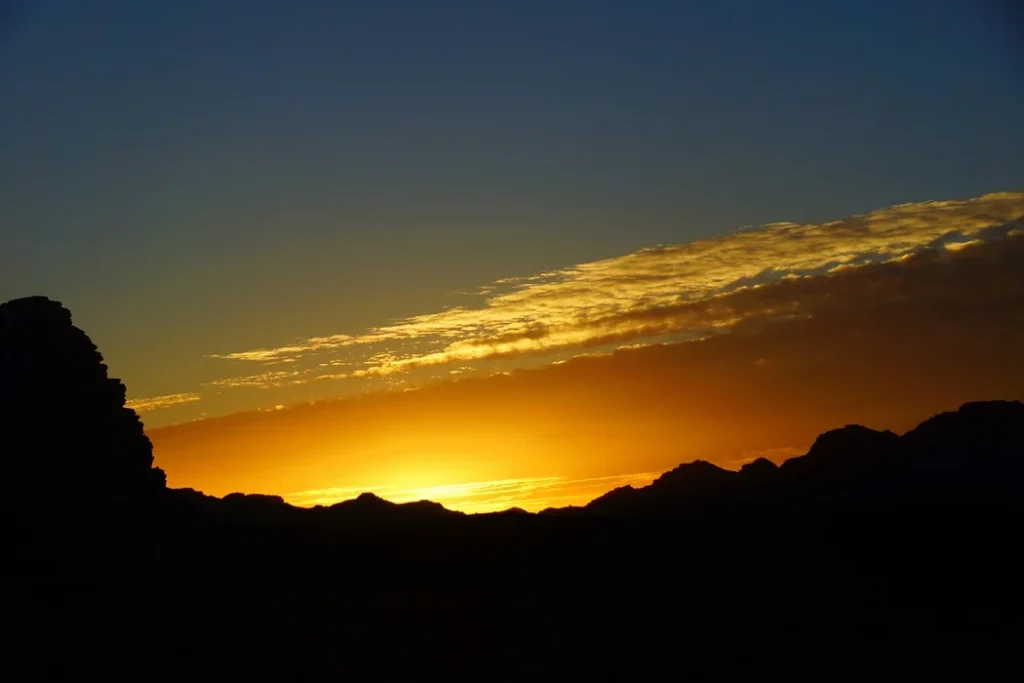
Exploring the Wadi Rum Desert
Geography and Landscape
Venturing into Wadi Rum is like stepping onto another planet. The desert’s geography is a mesmerizing blend of unique rock formations, vast sand dunes, and expansive valleys. Towering sandstone and granite mountains rise abruptly from the sandy floor, creating a dramatic and rugged landscape that has been sculpted by millennia of erosion.
One of the most iconic features is the Seven Pillars of Wisdom, a majestic rock formation named after T.E. Lawrence’s famous book. These towering columns stand as sentinels over the desert, their striated layers revealing the passage of time. Another notable site is Khazali Canyon, a narrow fissure in the mountainside adorned with ancient petroglyphs and inscriptions. Walking through the canyon, you can see carvings of humans and animals, offering a glimpse into the lives of the people who traversed these sands thousands of years ago.
The sand dunes themselves are a sight to behold. Ranging in color from deep reds to golden yellows, they shift and change with the winds, creating ever-changing patterns and textures. The interplay of light and shadow throughout the day paints the desert in a spectrum of hues, making it a paradise for photographers and nature enthusiasts alike.
Activities in Wadi Rum
Wadi Rum offers a plethora of activities that allow visitors to fully immerse themselves in this extraordinary environment.
Jeep Safaris and Guided Tours
One of the most popular ways to explore the desert is through jeep safaris. Guided tours in 4×4 vehicles take you deep into the heart of Wadi Rum, covering more ground than would be possible on foot. Experienced local guides share their knowledge of the area’s history, geology, and Bedouin culture. You’ll visit key landmarks, hidden valleys, and panoramic viewpoints that showcase the desert’s stunning beauty.
Hiking and Rock Climbing Opportunities
For the more adventurous, hiking and rock climbing offer exhilarating ways to experience the landscape up close. Trails range from easy walks suitable for most fitness levels to challenging climbs up sheer rock faces. The mountains of Wadi Rum are a climber’s dream, with routes that cater to both beginners and seasoned climbers. Ascending to the peaks rewards you with breathtaking vistas that stretch across the horizon.
Stargazing and Night Photography
When the sun sets, Wadi Rum transforms into one of the world’s premier stargazing locations. The absence of light pollution reveals a night sky brimming with stars, planets, and the Milky Way’s glowing band. Stargazing tours often include telescopes and expert guides who can point out constellations and celestial events. For photographers, the desert provides an ideal setting for night photography, capturing the stars above the silhouetted landscape.
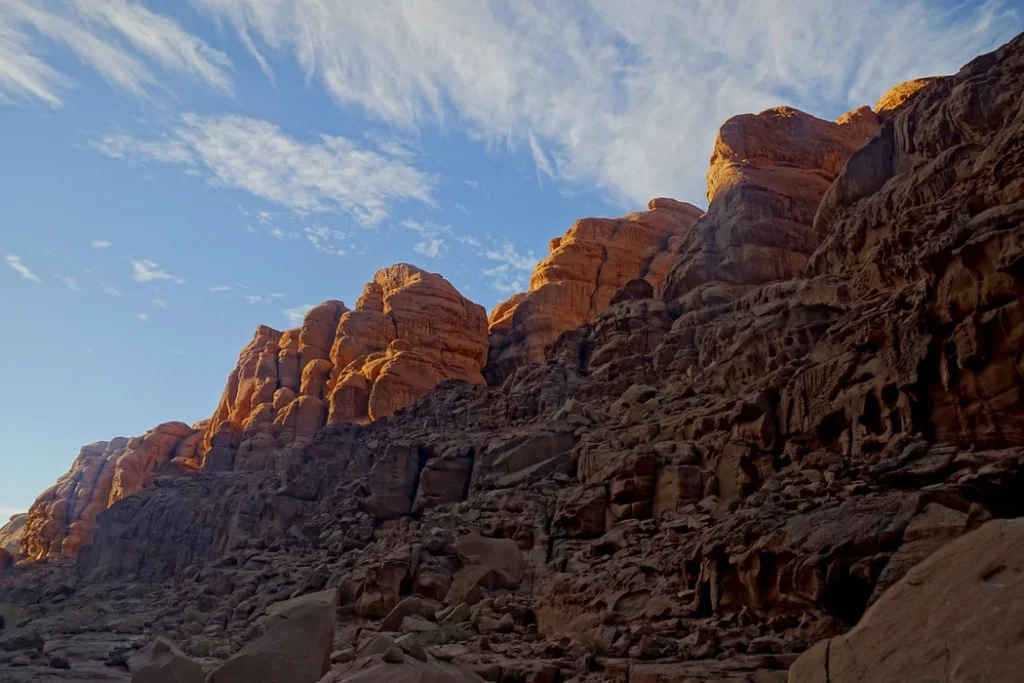
Environmental Conservation
While exploring Wadi Rum, it’s essential to recognize and support efforts to preserve this unique natural habitat.
Efforts to Preserve the Natural Habitat
Wadi Rum is designated as a protected area, managed by the Aqaba Special Economic Zone Authority (ASEZA) in collaboration with local communities. Conservation initiatives focus on protecting the delicate ecosystems, archaeological sites, and the traditional way of life of the Bedouin people. Sustainable tourism practices are encouraged to minimize the impact on the environment.
Responsible Tourism Practices
As visitors, we play a crucial role in preserving Wadi Rum for future generations. Here are some ways to practice responsible tourism:
- Stay on Designated Paths: Avoid disturbing wildlife and vegetation by sticking to established trails and tracks.
- Respect Cultural Sites: Refrain from touching or defacing rock carvings and archaeological sites.
- Minimize Waste: Carry out all trash and dispose of it properly. Consider using reusable water bottles and containers.
- Support Local Communities: Choose tours and accommodations run by local Bedouin families to contribute to the local economy.
- Conserve Water and Resources: Be mindful of resource usage, especially water, which is scarce in the desert.
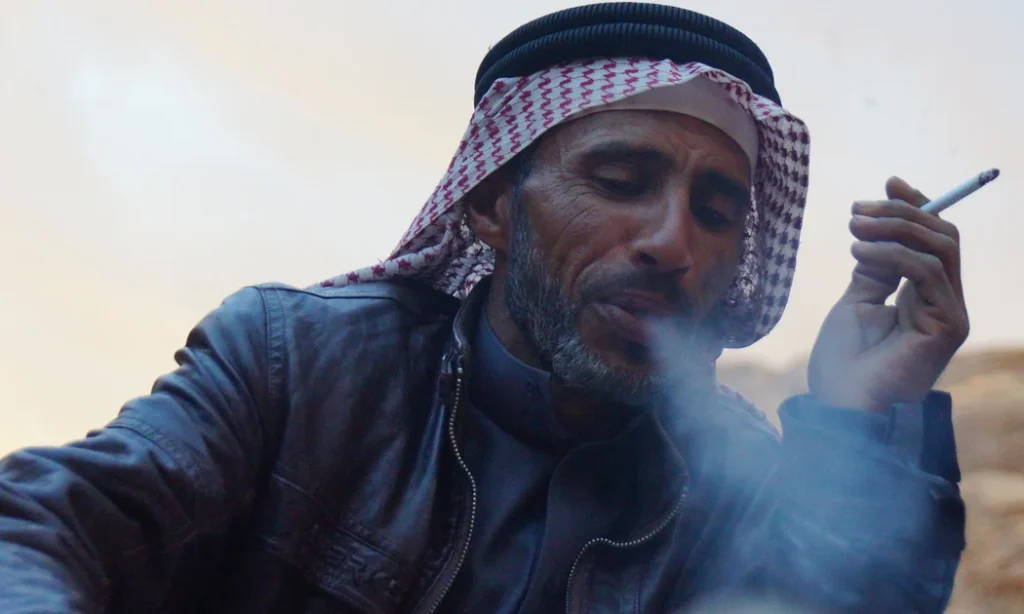
Immersing in Bedouin Culture
Staying in a Bedouin Tent
One of the most enriching experiences in Wadi Rum is spending the night in a Bedouin tent. This offers a unique opportunity to immerse yourself in the traditional lifestyle of the desert’s indigenous people.
Types of Accommodations Available
There are various types of Bedouin camps scattered throughout Wadi Rum, catering to different preferences and budgets. Some camps are authentic and rustic, providing a true nomadic experience with basic facilities. Others are luxury camps, often referred to as “glamping,” offering more comfort while still embracing Bedouin traditions.
Common types of accommodations include:
- Traditional Tents: Made from goat hair and woven fabrics, these tents offer a genuine Bedouin living experience.
- Modern Tents with Amenities: These come equipped with beds, electricity, and sometimes private bathrooms.
- Luxury Camps: Featuring amenities like air conditioning, en-suite bathrooms, and even Wi-Fi, for those seeking comfort.
Amenities and What to Expect
While staying in a Bedouin camp, you can expect varying levels of amenities depending on the type of camp you choose.
In general, you can expect:
- Communal Areas: Central tents or spaces where guests gather for meals and socializing.
- Basic Bedding: Comfortable mattresses and blankets to keep you warm during the chilly desert nights.
- Shared Bathrooms: Many camps have shared toilet and shower facilities, though some offer private ones.
- Traditional Décor: Interiors adorned with colorful rugs, cushions, and lanterns, reflecting Bedouin aesthetics.
Remember, the emphasis is on simplicity and connecting with nature. The absence of modern distractions allows you to fully appreciate the serene environment and the star-filled skies above.
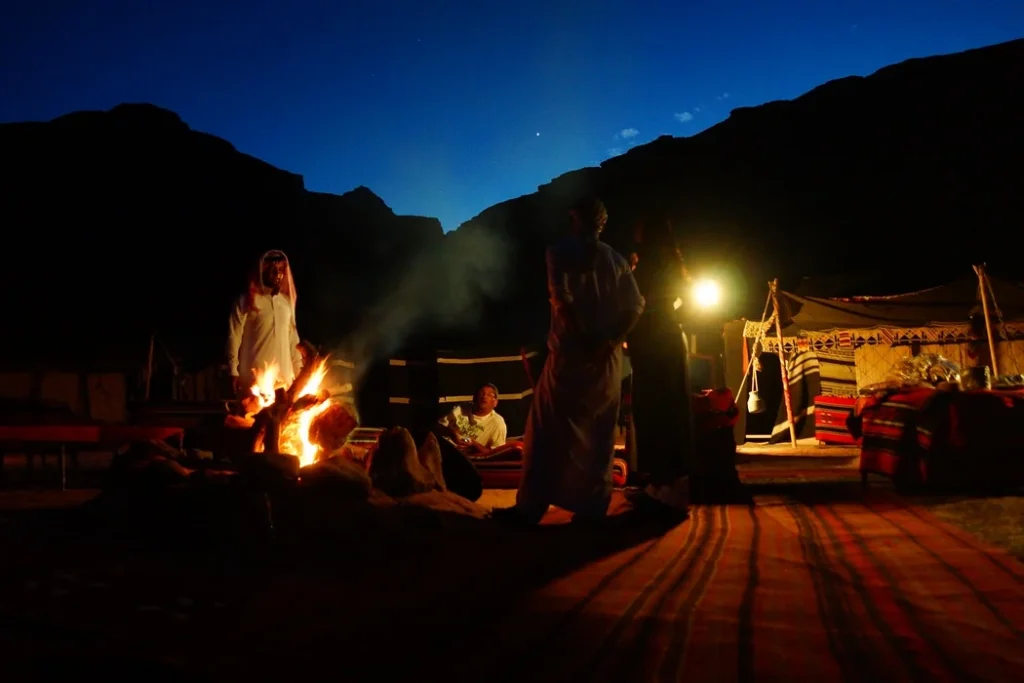
Bedouin Hospitality and Cuisine
The Bedouin people are renowned for their hospitality. As a guest in their camp, you will be treated with warmth and generosity, making your stay truly memorable.
Traditional Meals like Zarb (Bedouin Barbecue)
Food is an integral part of Bedouin culture. You will have the chance to savor traditional dishes prepared using age-old methods.
Highlights include:
- Zarb: A Bedouin barbecue where meat and vegetables are cooked underground in a sand oven. The slow-cooking method infuses the food with rich, smoky flavors.
- Mansaf: Jordan’s national dish, consisting of lamb cooked in a fermented dried yogurt sauce and served with rice.
- Fresh Flatbread: Baked over open fires, perfect for scooping up dips and accompanying meals.
Meals are typically enjoyed family-style, with guests gathering around large platters. This communal dining fosters a sense of togetherness and provides an opportunity to engage with fellow travelers and hosts.
Social Customs and Etiquette
Understanding and respecting Bedouin customs will enhance your experience.
Key etiquette tips:
- Greetings: A warm handshake and a smile go a long way. Use phrases like “Marhaba” (hello) and “Shukran” (thank you).
- Dress Modestly: While the Bedouins are welcoming, modest attire shows respect for their cultural norms.
- Accepting Offers: It’s polite to accept food and drink when offered. Refusing hospitality can be considered impolite.
- Right Hand Use: Use your right hand when eating or passing items, as the left hand is considered unclean.
Engaging with your hosts, asking questions, and showing interest in their way of life will deepen your connection and understanding of their rich cultural heritage.
Cultural Activities
Immersing yourself in Bedouin culture extends beyond sleeping in a tent and sharing meals. Participating in traditional activities enriches your experience.
Music and Storytelling Around the Campfire
Evenings in Wadi Rum are magical. After dinner, guests often gather around the campfire under a canopy of stars.
Activities include:
- Traditional Music: Listen to melodies played on instruments like the rebab and the oud. The music reflects the rhythms of desert life.
- Storytelling: Bedouin hosts may share tales passed down through generations, including legends, folklore, and personal anecdotes.
- Poetry Recitals: Poetry is highly valued in Bedouin culture. Recitations often express love, bravery, and the beauty of the desert.
These intimate gatherings offer insight into the Bedouins’ connection to their land and traditions.
Camel Herding and Traditional Crafts
Engage in daytime activities that showcase Bedouin skills and craftsmanship.
Opportunities may include:
- Camel Herding: Learn about the importance of camels in Bedouin life. You might assist in herding or feeding, gaining hands-on experience.
- Weaving and Handicrafts: Discover traditional methods of weaving rugs, tents, and other items using goat hair and wool.
- Desert Navigation: Understand how the Bedouins read the stars and landscape to navigate the vast desert without modern tools.
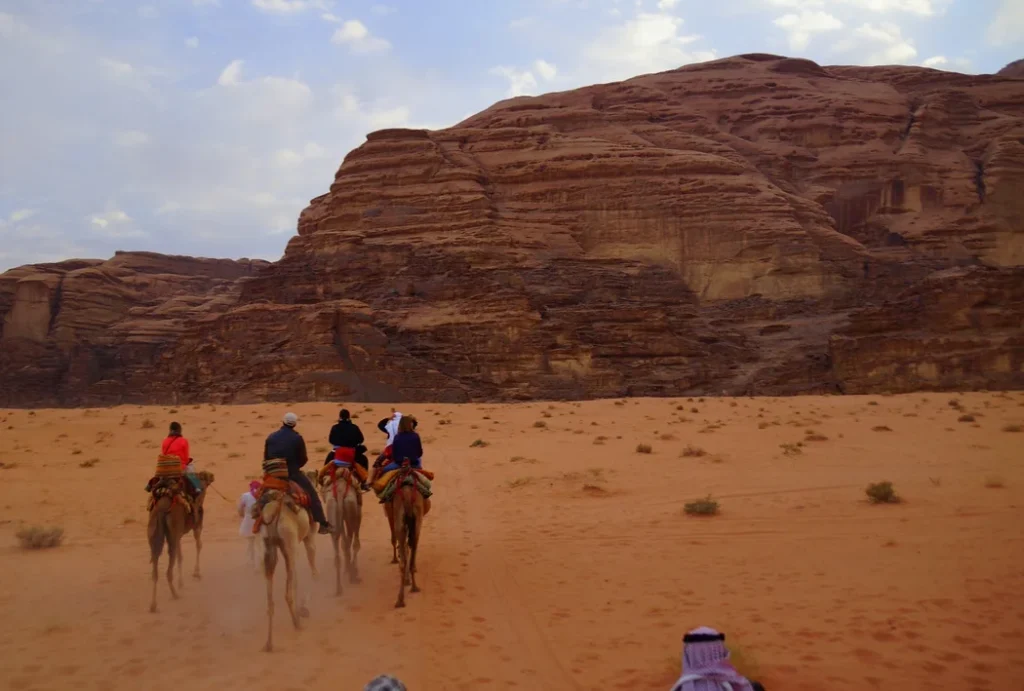
Camel Riding Experience
The Significance of Camels in Bedouin Life
Camels are more than mere animals in the desert; they are an integral part of Bedouin culture and heritage. For centuries, these resilient creatures have been the backbone of Bedouin life, serving as essential companions in transportation, trade, and daily survival. The Bedouins, nomadic by nature, relied heavily on camels to navigate the vast expanses of the desert. These “ships of the desert” could carry heavy loads over long distances without water, making them indispensable for moving goods and people across arid landscapes.
The historical reliance on camels for transportation and trade cannot be overstated. Camels enabled the Bedouins to establish and maintain trade routes across the Middle East, facilitating the exchange of spices, textiles, and other valuable commodities. They also played a crucial role in communication between distant tribes and settlements, fostering connections that were vital for survival in the harsh desert environment.
Beyond their practical uses, camels hold deep cultural symbolism within Bedouin society. They represent wealth, status, and a profound connection to ancestral traditions. Ownership of camels was a sign of prosperity, and they often featured prominently in dowries and tribal negotiations. Camels are celebrated in Bedouin poetry, songs, and folklore, embodying qualities such as endurance, patience, and resilience. This cultural reverence highlights the unique bond between the Bedouins and their camels, a relationship built on mutual dependence and respect.
Planning Your Camel Ride
When considering booking options, you have several choices. Many Bedouin camps offer camel rides as part of their accommodation packages, providing convenience and a seamless integration into your stay. Alternatively, you can arrange rides through local tour operators who specialize in desert excursions. It’s advisable to research and choose reputable operators with positive reviews to ensure a safe and enjoyable experience. Booking in advance, especially during peak tourist seasons, can help secure your preferred date and time.
The duration and route choices for your camel ride depend on your interests and schedule. Short rides, typically lasting one to two hours, are ideal for those who wish to experience camel riding while exploring nearby attractions. These excursions often include visits to notable sites such as Lawrence’s Spring or the Red Sand Dunes. For a more immersive experience, half-day or full-day treks take you deeper into the desert, offering breathtaking views and opportunities to witness the raw beauty of Wadi Rum. If you’re up for an unforgettable adventure, consider an overnight camel trek. Spending the night under the stars, much like the Bedouins have for generations, provides a unique perspective on desert life.
Getting to Wadi Rum
Transportation Options
Reaching Wadi Rum is relatively straightforward, with several transportation methods available from major cities in Jordan. Whether you’re coming from the bustling capital of Amman or the coastal city of Aqaba, you have choices that cater to different preferences and budgets.
From Amman or Aqaba by Car or Bus
By Car:
- From Amman: The drive to Wadi Rum takes approximately 4 hours. The route is well-marked, and renting a car gives you the freedom to explore at your own pace. You’ll travel south on the Desert Highway (Highway 15), passing through scenic landscapes that offer glimpses of Jordan’s diverse terrain.
- From Aqaba: A shorter journey, the drive from Aqaba to Wadi Rum is about 1 hour. This proximity makes Aqaba an excellent starting point, especially if you’re arriving via the King Hussein International Airport.
By Bus:
- Public Buses: From Amman’s South Bus Station, you can catch a bus to Aqaba and request to be dropped off at the turnoff to Wadi Rum. From there, local taxis can take you to the Visitor Center.
- Jett Buses: A more comfortable option, Jett operates daily buses between Amman and Aqaba. However, services directly to Wadi Rum are limited, so additional transportation from Aqaba may be necessary.
Guided Tours vs. Independent Travel
Choosing between a guided tour and traveling independently depends on your desired experience.
Guided Tours:
- Convenience: Guided tours handle all logistics, including transportation, accommodation, and activities.
- Expert Insight: Professional guides offer valuable information about the area’s history, geology, and culture.
- Social Experience: Joining a group tour provides opportunities to meet fellow travelers.
Independent Travel:
- Flexibility: Travel at your own pace, spend more time at sites that interest you, and adjust your itinerary as you wish.
- Cost-Effective: Potentially lower costs by arranging your transportation and accommodations directly.
- Authentic Encounters: Opportunities to interact directly with locals and tailor your experiences.
Both options have their merits. If you prefer a structured schedule with less planning on your part, a guided tour might be ideal. On the other hand, independent travel offers a sense of adventure and personalization.
Best Time to Visit
Timing your visit to Wadi Rum is crucial to fully enjoy what the desert has to offer. The region’s climate and seasonal events can significantly impact your experience.
Climate Considerations
Wadi Rum experiences a desert climate, characterized by hot summers and cool winters.
- Spring (March to May): One of the best times to visit. Temperatures are moderate, ranging from 15°C to 25°C (59°F to 77°F). The desert blooms with wildflowers, adding splashes of color to the landscape.
- Summer (June to August): Temperatures can soar above 38°C (100°F). The intense heat makes daytime activities challenging, but nights are warm and pleasant. If you visit during summer, plan outdoor excursions early in the morning or late in the afternoon.
- Autumn (September to November): Similar to spring, autumn offers comfortable temperatures and clear skies, ideal for stargazing and exploring.
- Winter (December to February): Days are cool, averaging 10°C to 15°C (50°F to 59°F), but nights can be cold, dropping close to 0°C (32°F). Warm clothing is essential if traveling during this period.
Seasonal Events and Festivals
While Wadi Rum is known for its timeless tranquility, certain events can enhance your visit.
- Jordan Independence Day (May 25th): Nationwide celebrations may include events in nearby towns, offering a glimpse into local patriotism and culture.
- Aqaba Traditional Arts Festival: Held annually in Aqaba, this festival showcases Jordanian arts, crafts, music, and dance. Its proximity to Wadi Rum makes it a worthwhile addition to your itinerary.
- Ramadan: During the holy month, the daily rhythm changes. While services remain available, be mindful of fasting practices, and expect adjusted opening hours.
Planning your trip around these events can provide enriching cultural experiences, but also consider potential impacts on accommodation availability and transportation.
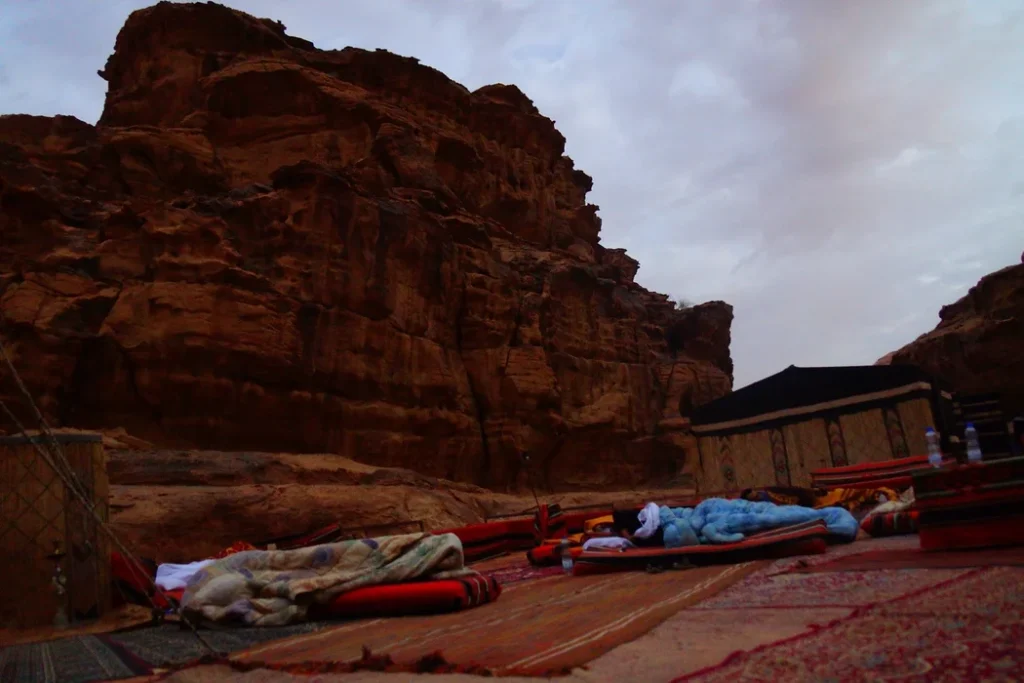
Entry Fees and Permits
Before you can explore the wonders of Wadi Rum, there are administrative details to address regarding entry fees and regulations.
Wadi Rum Protected Area Regulations
Wadi Rum is a designated Protected Area, managed to preserve its natural beauty and cultural heritage. To enter, all visitors must pass through the Wadi Rum Visitor Center, where regulations are enforced to minimize environmental impact.
- Entry Fee: The standard entry fee is 5 Jordanian Dinars (JD) per person (approximately $7 USD). Children under 12 often enter for free.
- Jordan Pass Holders: If you’ve purchased the Jordan Pass, which combines visa fees with entry to multiple attractions, your entrance to Wadi Rum is included. Present your pass at the Visitor Center.
Purchasing Tickets and Hiring Local Guides
At the Visitor Center, you can handle necessary formalities and make arrangements for your visit.
Purchasing Tickets:
- Payment Methods: Fees can typically be paid in cash (Jordanian Dinars). Some centers may accept credit cards, but it’s advisable to carry cash.
- Information Materials: Pick up maps and brochures that provide valuable information about the area.
Hiring Local Guides:
- Mandatory Guides: To preserve the environment and ensure safety, exploring certain areas requires a licensed local guide. This policy supports the Bedouin community economically and culturally.
- Tour Options: Guides offer various tours, from jeep safaris to camel treks and hiking excursions. Discuss your interests to tailor the experience.
- Negotiating Prices: While there are standard rates, there’s room for negotiation, especially if booking multiple activities or group tours.
By complying with these regulations and supporting local guides, you contribute to the sustainable tourism efforts that keep Wadi Rum pristine.
Wadi Rum Final Thoughts
From the moment you first set eyes on the vast expanse of the desert, you’re greeted by a panorama that defies imagination. The towering sandstone cliffs, sculpted by wind and time, stand like silent guardians over the endless sea of sand. Each sunrise paints the sky with hues of pink and gold, while sunsets drape the landscape in deep reds and purples. The natural beauty of Wadi Rum is unparalleled. It offers countless opportunities to pause and marvel at the wonders of the Earth.
A Connection with History
Walking through the ancient valleys and canyons, you tread the same paths once taken by Nabatean traders, Bedouin nomads, and adventurers like T.E. Lawrence. The whispers of the past echo in the petroglyphs etched into the rocks, telling stories of civilizations long gone yet preserved in the very stones of the desert. This connection to history adds a profound depth to your travels, transforming a simple journey into a pilgrimage through time.
Embracing Bedouin Hospitality
Perhaps one of the most enduring memories you’ll carry with you is the warmth and generosity of the Bedouin people. Their hospitality is not just a cultural practice but a way of life that welcomes strangers as friends. Sharing stories around the campfire, listening to the haunting melodies of traditional music, and savoring the rich flavors of Bedouin cuisine create bonds that transcend language and cultural barriers. It’s in these moments that you discover the true essence of community and human connection.
The Adventure of a Lifetime
Wadi Rum is a playground for the adventurous spirit. Whether you’re scaling the rugged cliffs, navigating the desert on a camel, or exploring hidden canyons, every activity challenges and exhilarates. The thrill of adventure is complemented by the serenity of the desert, where moments of quiet reflection are as abundant as opportunities for excitement. This balance allows you to push your limits while also finding peace within yourself.
Reflections Under the Stars
As night falls, the desert unveils one of its most breathtaking spectacles: a sky ablaze with stars. Free from the glow of city lights, the Milky Way stretches overhead in all its glory. Lying beneath this celestial canopy, you can’t help but feel a profound sense of wonder and humility. The vastness of the universe becomes tangible, offering a chance to contemplate your place within it. These nights spent stargazing become cherished memories, moments of introspection that linger long after you’ve returned home.
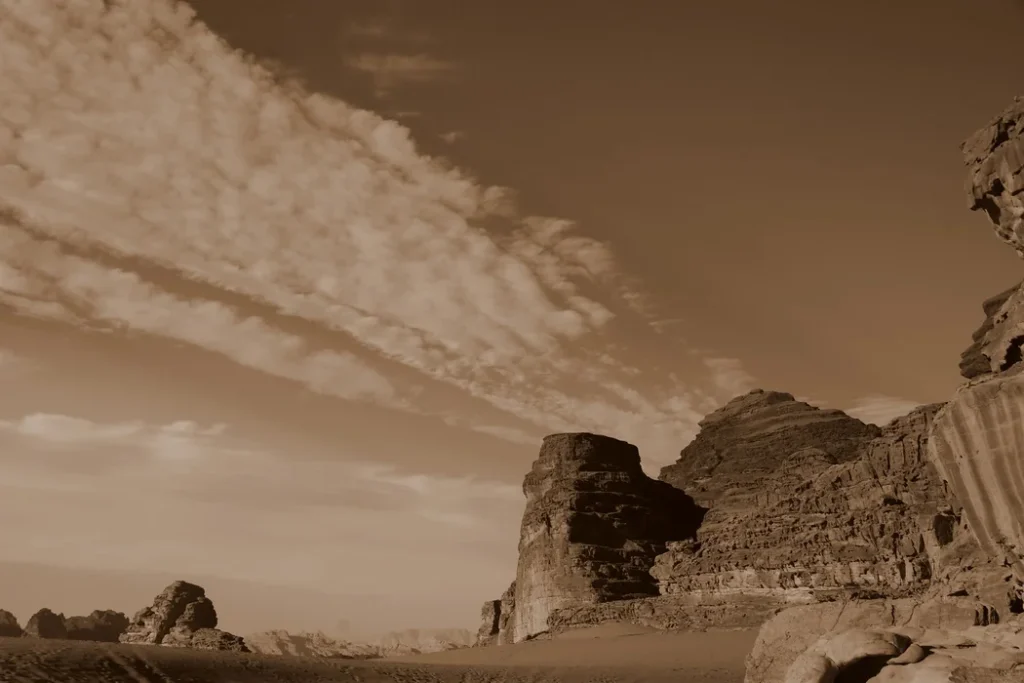
Lessons from the Desert
Wadi Rum teaches invaluable lessons about simplicity, resilience, and respect for nature. The Bedouin way of life, adapted perfectly to the harsh desert environment, demonstrates how living in harmony with nature leads to sustainability and fulfillment. Observing their customs and traditions, you gain insights into alternative ways of living that prioritize community, resourcefulness, and a deep connection to the land.
An Invitation to Return
Wadi Rum is a place that calls you back. Its ever-changing landscapes and timeless beauty ensure that no two visits are the same. Whether it’s to explore new corners of the desert, reconnect with friends made along the way, or simply to rediscover the peace found beneath its starry skies, the Valley of the Moon always welcomes you with open arms.
